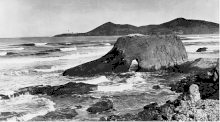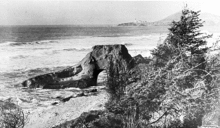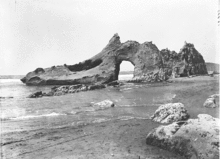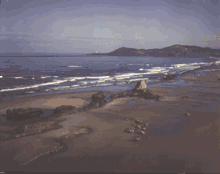Jump-off Joe
Jump-off Joe was a 100-foot-tall sea stack geological formation composed of middle Miocene concretionary sandstone[1] at Nye Beach in Newport, Oregon, United States.[2] It was a well-known tourist attraction before World War I.[3] It formed sometime before the 1880s when it was connected to the mainland, and was a major impediment walking the beach.[3] Early travelers would have to jump off the side to get over it, hence the name. Early writers claimed the site was connected with Native American mythology.[3] Natural forces separated it from the mainland in the 1890s, and its large arch collapsed in 1916.[3]





Etymology
The name "Jump-Off Joe" originated from the son of Dr. John McLoughlin, Joseph. Joseph accidentally fell near the rock during a trapping expedition but managed to survive for nine more years before dying of his injuries. The rock was originally known as "The Jump-Off Where Joe Fell", before being shortened to "Jump-Off Joe".
Key Events
- Between 1920 and 1970, the majority of the sea stack collapsed, and by 1990 it had been swept away, and little trace remains today.
- In 1970 and 1990, members of the United States Geological Survey photographed the remains of the sea-stack.
- In late January of 2021, Jump-Off Joe was affected by a landslide and closed it off to the public due to safety risks. [4]
References
External links
- Historic images of Jump Off Joe from Salem Public Library